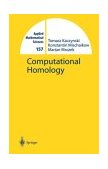 |
Computational Homology
Tomasz Kaczynski, Konstantin Mischaikow, Marian Mrozek.
Springer-Verlag (2004), price $69.95, ISBN: 0387408533.
|
| Reviewer: R. Ghrist, University of Illinois Urbana-Champaign, USA. |
Dynamical systems is principal among those fields in applied mathematics for which global and qualitative methods reign. Indeed, any modern textbook in dynamical systems theory likely relies on concepts and methods from topology as often as from analysis. It is no coincidence that Poincare is considered the father of both qualitative dynamical systems and algebraic topology. Neither is it surprising that a significant number of prominent dynamical systems researchers from the American and Russian schools in the latter half of the 20th century came from a background in topology (with many of these making deep contributions to applied mathematics in turn).
The textbook under review concerns one of the fundamental tools of topology: homology. Briefly put, homology counts things. Given a topological space X (think of a configuration space or an invariant set) the homology of X is (in its simplest incarnation) a sequence of vector spaces H0(X), H1(X) ,..., with each Hk(X) being a measure of how many and what types of "holes" in X can be caught in a k-dimensional net.
For example, the rank of H0(X) is equal to the number of path components of X. This is precisely the type of question that zero-dimensional subsets can answer: do two points in X bound a curve between them?
To continue the image: H1(X) counts those holes which can be detected by loops in X which do not bound an orientable surface in X. Thus, for a graph, H1 has dimension equal to the number of independent cycles. A 2-d sphere has H1 = 0, since any loop on that sphere bounds a disc. A 2-d torus (a circle cross a circle) has H1 = R2, a convenient basis being a pair of meridional and longitudinal circles.
(Caveat: the theory of homology is much deeper and more algebraic in nature than indicated here.)
Homology theory enters applied mathematics in an increasing number of ways. The reader of "Computational Homology" will find ample evidence of the relevance of homology to problems in vision and segmentation, pattern formation and classification, and dynamical systems.
Homology theory has its most obvious connections to dynamical systems through fixed point theory. For example, the classical Brouwer fixed point theorem (every continuous map of a closed n-dimensional disc into itself has a fixed point) has a homological proof. The more refined Lefshetz fixed point theorem cannot even be stated without homology: briefly, one can obtain information about fixed points of f:X->Y by knowing to which elements of Hk(Y) the basis elements of Hk(X) are sent. More refined expressions of homology in dynamics are in the generalizations of Morse theory due to Conley (for finite dimensional dynamical systems) and Floer (for infinite dimensional gradient flows).
Recent contributions of the Conley index to dynamical systems include rigorous methods for detecting chaotic invariant sets in continuous and discrete systems, for finding time-periodic solutions to PDEs, and for verifying dynamics of experimental time series data.
In all of these applications, one discretizes the phase space of a dynamical system to a finite dimensional cubical grid on which the dynamics acts as a multi-valued mapping. To use, e.g., the Conley machinery, it is necessary to compute the topological type of a certain subcomplex. This is where homology enters the picture: homology is one of the few computationally feasible invariants of a topological space. Yet invoking the phrase "Homology is computable" is not the same as computing it: many applications require computing homology of very large inputs. This is the principal challenge which this text addresses.
The text is designed for advanced undergraduate mathematics students and beginning graduate students in related fields (engineering, computer science, physics, etc.). There is an ample set of appendices to cover prerequisites in point-set topology and algebra (for the latter group of students) and data structures and algorithms (for the former).
The text proceeds through the basics of homology theory, with ample motivations from concrete application domains. In nearly all aspects of the presentation, there is a computational tone which informs the choices made in exposition.
There are no comparable texts available. The classical text of Massey is the only source this reviewer is aware of which uses a reminiscent cubical homology theory; that text is brief and elegant, but dated and of limited value to scientists. The book under review has none of these qualities. It is comprehensive, modern, and ideal for mathematical scientists of all types who wish to use contemporary topological tools in a computational setting. Since the emphasis is computational, the text suffers from a sometimes cumbersome notation and a general lack of elegance. This is not unexpected: a comparison of dynamical systems texts which emphasize theory versus those which emphasize numerical methods yields similar results. Overall, the text is a unique and valuable contribution to the literature on contemporary methods in dynamical systems and applied mathematics as a whole.